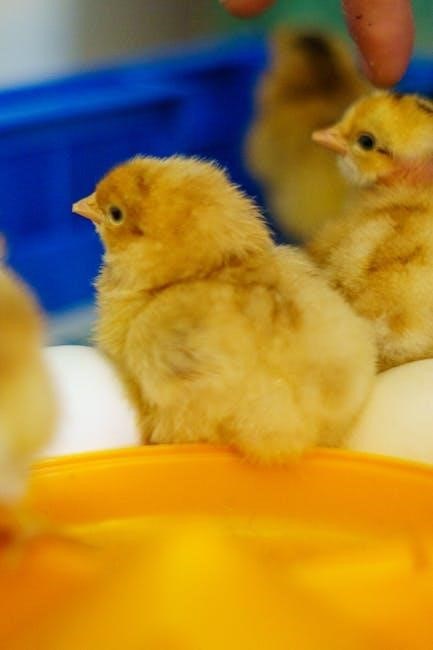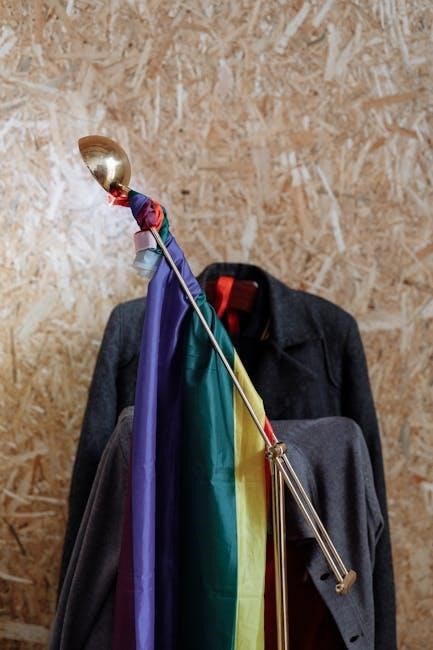The Nature Right 360 Incubator is a user-friendly, advanced egg incubator designed for hatching chicken, duck, and pheasant eggs with high success rates.
Overview of the Nature Right 360 Incubator
The Nature Right 360 Incubator is a versatile and advanced device designed for hatching eggs of chickens, ducks, and pheasants. It features an automatic egg turner, temperature, and humidity control, ensuring optimal conditions for embryo development. The incubator also includes a built-in LED candler for monitoring egg progress without opening the unit. With its user-friendly interface and 360-degree visibility, it provides a controlled environment for successful hatching. The device is ideal for both beginners and experienced users, offering a seamless experience from setup to hatching.
Key Features of the Nature Right 360 Incubator
The Nature Right 360 Incubator boasts an automatic egg turner that mimics a hen’s natural turning process, ensuring even development. It features precise temperature and humidity controls, a built-in LED candler for egg monitoring, and a 360-degree viewing window for observing progress. The incubator also includes an Auto-Stop function, halting egg turning three days before hatching to prevent damage. Its user-friendly design, combined with advanced features, makes it an ideal choice for achieving high hatch rates and a successful incubation experience.

Unpacking and Initial Setup
Carefully unpack the Nature Right 360 Incubator, ensuring all components like the egg turner, water pots, and power cord are included and undamaged.
Unpacking the Incubator
Carefully unpack the Nature Right 360 Incubator, ensuring all components, including the egg turner, water pots, and power cord, are included and free from damage. Check the bottom of the box, as the power cord may be stored beneath the incubator. Inspect each part for completeness and functionality. If any items appear missing or damaged, refer to the manual or contact support. Place the incubator on a stable, flat surface away from direct sunlight and drafts to ensure optimal performance during operation.
Inspecting Components and Accessories
Upon unpacking, inspect all components for damage or defects. The incubator includes two water pots (Pot A and Pot B), with Pot B having a cover, while Pot A remains uncovered for dual-phase use. Ensure the egg turner, control panel, and Grey Air Vent are present and functional. Check the power cord, which may be located under the incubator. Verify that all accessories are complete and undamaged. If any items are missing or damaged, contact the manufacturer immediately. This step ensures proper setup and operation of the incubator.
Placing the Incubator in a Suitable Location
Position the Nature Right 360 Incubator in a room with stable temperatures between 74°F and 80°F. Avoid direct sunlight, drafts, or extreme humidity to maintain optimal conditions. Place the incubator on a sturdy, level surface to ensure even operation. Keep it away from pets or children to prevent accidental disturbances. Proper placement ensures consistent temperature and humidity levels, which are critical for successful incubation and hatching. This step is essential for creating a stable environment for your eggs.

Understanding the Incubator Components
The Nature Right 360 Incubator includes water pots, an egg turner, control panel, and grey air vent, each playing a vital role in maintaining optimal incubation conditions.
Water Pots (Pot A and Pot B)
The Nature Right 360 Incubator includes two water pots, Pot A and Pot B, essential for maintaining humidity during incubation. Pot A, used during both incubation phases, does not have a cover, while Pot B is covered. Fill Pot A with water before starting, and adjust the grey air vent to regulate moisture levels. Proper water levels in these pots ensure consistent humidity, crucial for egg development. Monitor and refill as needed to maintain optimal conditions for hatching.
Egg Turner and Its Function
The Egg Turner in the Nature Right 360 Incubator simulates the natural turning process of a brooding hen, ensuring eggs are evenly heated and developed. It automatically stops turning three days before hatching to prepare for the hatching phase. This feature enhances hatch rates by mimicking natural incubation conditions. Regularly check the Turner’s function to ensure smooth operation and optimal egg positioning throughout the incubation process. Proper egg turning is vital for embryo development and successful hatching.
Control Panel and LED Display
The Control Panel on the Nature Right 360 Incubator is user-friendly, featuring buttons to manage settings like temperature, humidity, and the egg-turning function. The LED Display shows real-time data, including temperature, humidity levels, and days-to-hatch countdown. It also indicates when the egg turner is active or in auto-stop mode. The display automatically turns off after five minutes to conserve power. This panel ensures precise control over incubation conditions, making it easy to monitor and adjust settings for optimal egg development and hatching success.
Grey Air Vent and Its Role
The Grey Air Vent is a crucial component of the Nature Right 360 Incubator, regulating air circulation and humidity inside the incubation chamber. Proper ventilation ensures healthy embryo development and prevents moisture buildup. The vent should be fully open during cleaning and can be adjusted during incubation to maintain optimal humidity levels. It works in tandem with the water pots to create the right environment for hatching. Regular monitoring of the vent’s position is essential to achieve consistent incubation conditions and successful hatching outcomes.
Setting Up the Incubator
Setting up the Nature Right 360 Incubator involves carefully assembling components, connecting the power supply, and preparing water pots for humidity control to ensure optimal conditions.
Assembling the Incubator
Start by carefully unpacking and inspecting all components, ensuring no damage or missing parts. Attach the egg turner to the base, aligning it properly for smooth operation. Next, connect the power supply unit to the incubator top, ensuring secure placement. Fill water pots A and B according to instructions, placing them in their designated areas. Finally, plug in the incubator and allow it to run dry for 24 hours to ensure proper functionality before adding eggs. This step ensures optimal preparation for incubation.
Connecting the Power Supply
To connect the power supply, locate the socket on the incubator’s top. Plug the egg turner cord from the base into this socket. Next, attach the power supply unit to the incubator’s designated port. For 12V battery use, cut the plug and connect the wires accordingly. Ensure all connections are secure to avoid power issues. Once connected, test the incubator by turning it on to confirm proper operation. This step ensures reliable power delivery for optimal incubation performance.
Filling Water Pots for Humidity
To maintain optimal humidity, fill Water Pot A with distilled water as it is used throughout incubation. Water Pot B, covered, is typically reserved for later stages. Ensure both pots are placed correctly to prevent leakage. Avoid overfilling, as this can cause excessive humidity. Refill as needed based on the incubator’s humidity levels. Proper water management ensures consistent conditions for egg development. Always use clean water to maintain hygiene and prevent contamination. This step is crucial for achieving the best hatching results.
Setting the Initial Temperature
Before adding eggs, set the incubator’s temperature to 99-100°F (37.2-37.8°C) using the control panel. Ensure the incubator is preheated for 1-2 hours to stabilize. The Nature Right 360 Incubator is pre-programmed for optimal temperature settings, but manual adjustments can fine-tune the environment. Always verify the temperature reading on the LED display before placing eggs inside. Proper temperature setup is critical for embryo development and successful hatching. Allow the incubator to reach and maintain the set temperature consistently.
Operating the Incubator
The Nature Right 360 Incubator operates seamlessly with its automatic egg turner, temperature control, and humidity management systems, ensuring optimal conditions for egg development and hatching success.
Placing Eggs in the Incubator
Before placing eggs in the Nature Right 360 Incubator, ensure the unit is at the correct temperature (99-100°F) and humidity (45-55%). Gently position the eggs in the incubator, pointing the large end upward. Ensure the egg turner is properly connected and functioning. Once the eggs are placed, the incubator will automatically turn them, simulating a natural incubation process. Avoid opening the incubator during this phase to maintain stable conditions. The LED display will monitor progress, ensuring optimal hatching results.
Monitoring Temperature and Humidity Levels
Regularly monitor the temperature and humidity levels using the LED display on the control panel. The ideal temperature for incubation is 99-100°F, while humidity should be maintained at 45-55%. Adjust the grey air vent to regulate humidity levels, ensuring optimal conditions for egg development. Check water levels in the reservoirs periodically to maintain proper humidity. Avoid frequent opening of the incubator lid to prevent fluctuations. The built-in LED display provides real-time updates, allowing you to make precise adjustments for a successful hatching process.
Understanding the Egg Turner Function
The egg turner in the Nature Right 360 Incubator simulates the natural turning process of a brooding hen, ensuring even development of embryos. It operates automatically, gently rolling the eggs at regular intervals. The turner stops three days before hatching due to the Auto-Stop feature, allowing eggs to settle for the hatching phase. This feature is crucial for preventing damage to developing chicks and ensuring a smooth transition to hatching. Regular monitoring of the turner’s function is essential to guarantee optimal performance and high hatch rates.
Using the Built-In LED Candler
The Nature Right 360 Incubator features a built-in LED candler, allowing you to monitor egg development without opening the incubator. This non-invasive feature emits a safe, high-intensity light to illuminate the egg, making it easier to observe veining, movement, or developmental issues. Simply press the candler button on the control panel to activate the light. Regular candling helps track progress and ensures a healthy incubation process. This tool is especially useful during the hatching phase to confirm embryo activity and readiness for emergence.
Daily Maintenance and Monitoring
Regularly monitor temperature, humidity, and water levels to ensure optimal conditions. Adjust the grey air vent as needed and maintain proper ventilation for healthy incubation.
Checking Water Levels in the Reservoir
Regularly inspect the water levels in both Pot A and Pot B to maintain proper humidity. Pot A, used during incubation, has no cover, while Pot B is sealed. Refill Pot A as needed with distilled water to prevent mineral buildup. Ensure Pot B remains closed unless specified. Low water levels can disrupt humidity, affecting egg development. Always use distilled water to avoid contamination. Check daily to maintain stable conditions for optimal hatching success. Monitor closely to prevent overfilling, which can also impact performance.
Adjusting the Grey Air Vent
The grey air vent regulates humidity and airflow within the incubator. During incubation, set the vent to halfway to maintain optimal conditions. As the hatching phase approaches, fully open the vent to ensure proper airflow, which is crucial for successful hatching. Adjustments may be needed based on environmental conditions to maintain stable humidity levels. Proper ventilation prevents excessive moisture buildup, ensuring healthy development. Regular checks are essential to ensure the vent is functioning correctly and providing the right environment for the eggs.
Ensuring Proper Ventilation
Proper ventilation is crucial for maintaining optimal conditions inside the incubator. Ensure the incubator is placed in a well-ventilated room to prevent moisture buildup and maintain stable humidity levels. Avoid placing the incubator in confined or poorly ventilated spaces, as this can disrupt airflow and affect egg development. Regularly inspect the incubator’s vents and ensure they are not blocked. Proper ventilation promotes healthy egg development and prevents overheating, ensuring a successful hatching process.
Recording Incubation Progress
Regularly monitoring and recording incubation progress is essential for a successful hatch. Use the LED display to track days-to-hatch and ensure temperature and humidity levels are within optimal ranges. Maintain a log of daily observations, noting any adjustments made to settings. This helps identify patterns and potential issues early. Additionally, use the built-in LED candler to check egg development without opening the incubator, ensuring minimal disturbance to the eggs. Consistent record-keeping supports better understanding of the incubation process and improves future outcomes.
The Hatching Process
The hatching process begins 3 days before eggs hatch, when the Auto-Stop feature halts the egg turner. Monitor closely, ensuring humidity levels remain high for optimal hatch success.
Preparing for Hatching
Preparing for hatching involves stopping the egg turner 3 days before the expected hatch date. Ensure the grey air vent is fully open to increase humidity. Monitor temperature closely and avoid disturbances.
Understanding the Auto-Stop Feature
The Auto-Stop feature automatically halts the egg turner three days before hatching, preventing movement that could disturb the hatching process. This ensures eggs remain still during the critical hatching phase.
During hatching, observe eggs closely without opening the incubator. Use the built-in LED candler to check for pip and zipping activity. Maintain stable temperature and humidity levels, avoiding disturbances. Ensure the Auto-Stop feature is engaged to prevent egg movement. Allow the natural process to unfold, intervening only if necessary. Keep the incubator sealed to preserve conditions, promoting successful emergence of chicks. Patience is key during this critical phase. After hatching, carefully remove chicks from the incubator and transfer them to a safe, warm brooder. Discard unhatched eggs and clean the incubator thoroughly. Remove water pots, wash them with mild detergent, and rinse thoroughly. Wipe the interior with a clean, damp cloth, ensuring no residue remains. Allow the incubator to dry completely before storing. Regular cleanup prevents bacterial growth and ensures optimal performance for future use. Always follow safety guidelines when handling electrical components during cleaning. Regularly clean the incubator after each use to maintain efficiency and hygiene. Disconnect power, wash water pots with mild detergent, and dry thoroughly to prevent bacterial growth. Before cleaning, always disconnect the incubator from the power supply to ensure safety. Unplug the power cord from both the incubator and the wall outlet. This prevents any electrical hazards or unexpected turning on of the device. Additionally, if using a 12V battery connection, ensure the wires are disconnected. Allow the incubator to cool down if it has been in recent use. This step is crucial for safe handling and maintenance. Always refer to the user manual for specific instructions on disconnecting power. To maintain optimal humidity and prevent bacterial growth, regular cleaning of the water pots is essential. Remove Pot A and Pot B from the incubator and rinse them thoroughly with warm water. Use a mild detergent to scrub away any residue or mineral deposits. Avoid using abrasive materials that might scratch the surfaces. After cleaning, rinse the pots completely to ensure no soap residue remains. Allow them to air dry before refilling and placing them back into the incubator. Always refer to the manual for specific guidelines on handling the water pots. Thoroughly clean the egg turner and interior after each use to ensure a hygienic environment for your eggs. Remove any debris or residue from the turner’s surface using a soft brush or cloth. For tougher stains, mix a solution of mild detergent and warm water, and gently scrub the affected areas. Rinse thoroughly to eliminate any soap residue. Use a dry cloth to wipe down the interior walls, focusing on areas around the water pots and air vents. Avoid harsh chemicals to prevent damage to the incubator’s components. Regular cleaning promotes healthy incubation and prevents contamination. After cleaning, it’s crucial to thoroughly dry the incubator to prevent moisture buildup and bacterial growth. Use a clean, dry cloth to wipe down all surfaces, paying special attention to areas around the water pots and air vents. Leave the grey air vent fully open to ensure proper airflow. Allow the incubator to air dry for at least 24 hours before reuse. For added drying, plug in the unit without water and run it for a day. This step ensures the interior is completely dry and ready for the next incubation cycle. The Nature Right 360 Incubator may experience issues like temperature fluctuations or humidity problems. Always check power connections and ensure proper ventilation. Temperature fluctuations in the Nature Right 360 Incubator can affect egg development. Ensure the incubator is placed in a stable environment, away from drafts. Check the power supply for consistency, as unstable power can cause temperature variations. Verify that the grey air vent is properly adjusted, as incorrect settings may lead to fluctuations. If issues persist, recalibrate the temperature sensor according to the manual. Always monitor the LED display to maintain the optimal temperature range for successful incubation. Regular checks can help prevent sudden changes. Humidity issues in the Nature Right 360 Incubator can impact egg hatching success. Ensure Water Pot A is filled correctly, as it lacks a cover for proper evaporation. Avoid overfilling, as this can cause excessive moisture. If humidity levels drop, check for blockages in the grey air vent, which regulates airflow. Use distilled water for consistent humidity control. Monitor the LED display to maintain optimal levels, typically between 40-50% during incubation. Adjustments may be needed based on environmental conditions to ensure a stable humid environment for healthy embryo development. An egg turner malfunction can disrupt proper egg rotation, potentially affecting hatch rates. Ensure the turner cord is securely plugged into the incubator’s socket. Verify that the Auto-Stop feature is functioning correctly, as it should cease turning three days before hatching. If the turner stops prematurely, check for obstructions or misalignment. Regularly clean and lubricate moving parts to maintain smooth operation. If issues persist, refer to the user manual or contact support for assistance. Proper function is crucial for simulating natural hen-like turning and ensuring even embryo development during incubation. Power supply problems can disrupt incubation. Ensure the incubator is properly plugged into a grounded outlet. Check the power cord for damage or tangles. If using a 12V adapter, verify correct wire connections. Avoid overloading circuits, and use a surge protector to prevent damage from power spikes. If the incubator fails to turn on, ensure the outlet is functioning. For persistent issues, consult the user manual or contact customer support. A stable power supply is critical for maintaining consistent temperature and humidity levels during incubation. Always follow safety guidelines to avoid electrical hazards. Regularly clean and calibrate the incubator to ensure accuracy. Store it in a dry, cool place when not in use to maintain performance. After cleaning, ensure the incubator is completely dry before storing it in a cool, dry place. Disconnect the power supply and remove any accessories. Store the incubator in its original packaging or a protective cover to prevent damage. Avoid exposing it to extreme temperatures or humidity. Regularly inspect the unit before and after storage for any signs of wear or damage. Proper storage ensures optimal performance when you resume using the incubator for future hatching cycles. To ensure accuracy, calibrate the temperature sensor before first use. Place a reference thermometer inside the incubator and set the desired temperature. Allow the incubator to stabilize, then compare the readings. If necessary, adjust the sensor using the control panel to match the reference thermometer. Proper calibration ensures precise temperature control, which is crucial for successful incubation. Refer to the user manual for specific calibration instructions tailored to the Nature Right 360 model. This step guarantees optimal conditions for hatching eggs. Upgrading or replacing parts on the Nature Right 360 Incubator can enhance performance and extend its lifespan. Popular upgrades include adding extra water reservoirs or egg trays for increased capacity. When replacing parts, ensure they are compatible with the incubator’s model. Always purchase components from authorized suppliers to maintain functionality and safety. Before making any modifications, consult the user manual or contact customer support for guidance. Properly installed upgrades can improve humidity control, temperature accuracy, and overall incubation efficiency, ensuring optimal conditions for egg hatching. The Nature Right 360 Incubator combines user-friendly design with advanced features, ensuring optimal hatching conditions for poultry. Its versatility makes it ideal for all users. The Nature Right 360 Incubator is a reliable and feature-rich device designed to simplify the egg incubation process. With its automatic egg turner, precise temperature control, and built-in LED candler, it offers a comprehensive solution for hatching eggs. The incubator’s user-friendly interface and advanced features make it suitable for both beginners and experienced breeders. Regular maintenance and proper setup ensure optimal performance, leading to successful hatching outcomes. This incubator is a valuable tool for anyone looking to hatch eggs with confidence and ease. Successful hatching with the Nature Right 360 Incubator requires patience, attention to detail, and consistent monitoring. By following the provided instructions and maintaining optimal temperature and humidity levels, you can create a nurturing environment for your eggs. The incubator’s automatic features, such as the egg turner and humidity control, are designed to mimic natural conditions, maximizing hatch rates. Stay committed to the process, and you’ll enjoy the rewarding experience of witnessing your eggs hatch into healthy chicks.Monitoring the Hatching Phase
Post-Hatch Care and Cleanup

Cleaning and Maintaining the Incubator
Disconnecting Power Before Cleaning
Removing and Cleaning Water Pots
Cleaning the Egg Turner and Interior
Drying the Incubator After Cleaning
Troubleshooting Common Issues
Temperature Fluctuations
Humidity Level Problems
Egg Turner Malfunction
Power Supply Issues

Additional Tips for Optimal Performance
Storing the Incubator When Not in Use
Calibrating the Temperature Sensor
Upgrading or Replacing Parts
Final Thoughts on Using the Nature Right 360 Incubator
Encouragement for Successful Hatching